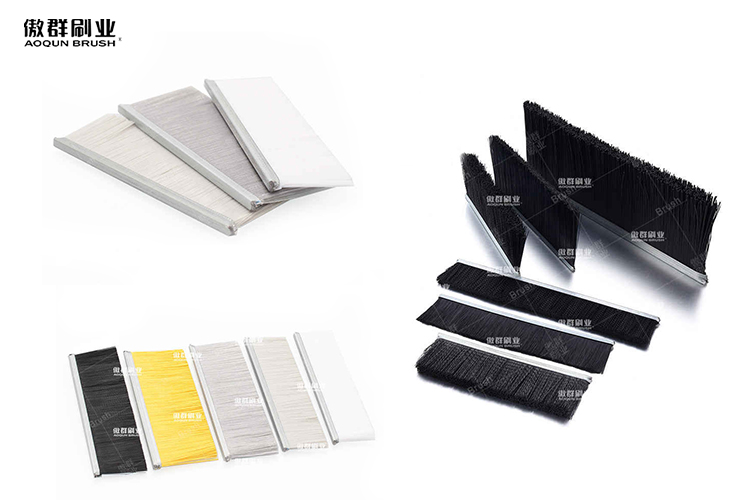Brush strips are versatile and flexible pieces of equipment that can be used in a wide variety of applications. They consist of a strip of bristles that are mounted onto a flexible backing, typically made of metal or plastic. The bristles can be made of a range of materials, including nylon, polypropylene, and natural fibres like horsehair or boar hair. Brush strips are commonly used to seal gaps and spaces in doors, windows, and other openings, but they have many other applications as well. In this guide, we'll explore the many uses of brush strips and how they can be employed in a variety of different settings.

One of the most common uses of brush strips is as weather stripping. Brush strips can be used to seal gaps around doors and windows, preventing drafts and keeping out moisture, dirt, and pests. Brush strips are particularly effective in sealing gaps in uneven surfaces or surfaces that move, like garage doors and sliding doors. The bristles of the brush strip can conform to the irregular surface, creating a tight seal that blocks out air and water.
In addition to weather stripping, brush strips can also be used to seal out dust and other particles. Brush strips can be installed on equipment like conveyor belts and other machinery to prevent dust and debris from escaping. This can be particularly useful in settings like food processing plants, where strict hygiene standards need to be maintained. Brush strips can also be used to seal around air filters, preventing dust and dirt from entering the system.
Brush strips can also be used to reduce noise levels. They can be installed on doors and windows to block out external noise, or on equipment like fans and compressors to reduce noise levels. Brush strips can be particularly effective in reducing high-frequency noise, which can be difficult to block out with traditional soundproofing materials.
Another common use of brush strips is in pest control. Brush strips can be installed on doors and windows to prevent insects and other pests from entering a building. They can also be used to seal gaps in walls and ceilings to prevent rodents and other pests from gaining access. Brush strips are particularly effective in preventing entry by small pests like mice and insects, which can squeeze through even small gaps.
Brush strips can also be used to clean conveyors and other equipment. They can be installed along the length of the conveyor, where they can remove debris and other particles from the surface. Brush strips can be particularly effective in removing sticky or difficult-to-remove materials, like adhesives or food residue. They can also be used to clean equipment like printing presses and laminators, where they can remove debris from the surface of the rollers.
Brush strips can also be used for cable management. They can be installed on the edges of panels and enclosures, where they can prevent cables from getting tangled or snagged. Brush strips can also be used to create a seal around the cables, preventing dust and debris from entering the enclosure. Brush strips can be particularly useful in industrial settings, where cables are often exposed to harsh conditions.
Brush strips can be used for cleaning and polishing a variety of surfaces. They can be used to clean carpets, upholstery, and other fabrics, where they can remove dirt and other particles from the fibres. Brush strips can also be used to polish metals and other hard surfaces, where they can remove oxidation and other surface imperfections. Brush strips can be particularly effective in cleaning and polishing intricate or hard-to-reach surfaces.
Brush strips can also be used in agriculture and farming. They can be used to clean and groom livestock, removing dirt and debris from their coats. Brush strips can also be used to remove excess hair and dander, promoting healthy skin and coat. In addition, brush strips can be used to clean and maintain farm equipment, such as tractors and harvesters.
Brush strips are commonly used in the printing industry. They can be used to clean and maintain printing presses, removing ink and other debris from the surface. Brush strips can also be used to apply ink to the printing surface, ensuring even distribution and preventing smudging. In addition, brush strips can be used to clean and maintain other printing equipment, such as laminators and cutters.
Brush strips can also be used in the automotive industry. They can be used to clean and maintain cars and trucks, removing dirt and debris from the surface. Brush strips can also be used to clean and maintain engines and other components, removing grease and other contaminants. In addition, brush strips can be used to seal gaps and spaces in vehicles, preventing drafts and reducing noise levels.
Brush strips are also used in the aerospace industry. They can be used to seal gaps and spaces in aircraft, preventing air and moisture from entering. Brush strips can also be used to clean and maintain aircraft engines, removing debris and ensuring optimal performance. In addition, brush strips can be used to create a seal around aircraft cables and wiring, preventing dust and other contaminants from entering the system.
Brush strips are commonly used in the marine industry as well. They can be used to seal gaps and spaces in boats and other watercraft, preventing water from entering. Brush strips can also be used to clean and maintain boat engines and other components, removing salt and other contaminants. In addition, brush strips can be used to clean and maintain boat decks and other surfaces, removing dirt and debris.
Brush strips can be used for a variety of home improvement projects. They can be used to seal gaps and spaces around doors and windows, preventing drafts and reducing noise levels. Brush strips can also be used to clean and maintain household appliances, such as vacuum cleaners and refrigerators. In addition, brush strips can be used to clean and maintain household surfaces, such as carpets and upholstery.
Brush strips can also be used in the medical industry. They can be used to clean and maintain medical equipment, removing bacteria and other contaminants. Brush strips can also be used to seal gaps and spaces in medical equipment, preventing contamination and reducing noise levels. In addition, brush strips can be used to clean and maintain medical facilities, such as hospitals and clinics.
Brush strips can be used in robotics as well. They can be used to clean and maintain robotic equipment, removing debris and ensuring optimal performance. Brush strips can also be used to create a seal around robotic cables and wiring, preventing dust and other contaminants from entering the system. In addition, brush strips can be used to prevent friction and wear in robotic joints and other moving parts.
As you can see, brush strips have a wide range of uses and applications. They can be used in everything from weather stripping to cable management, and from printing presses to robotic equipment. Brush strips are versatile, durable, and flexible, making them an ideal choice for a variety of different settings. Whether you're looking to seal gaps and spaces, reduce noise levels, or clean and maintain equipment, brush strips are a reliable and effective solution.

сканировать на wechat

сканировать на wechat
